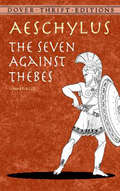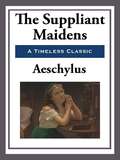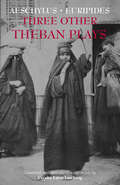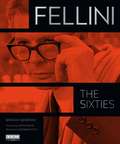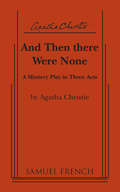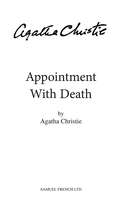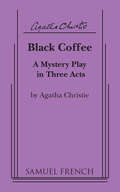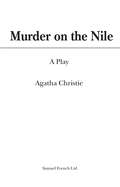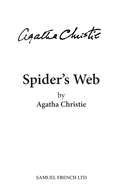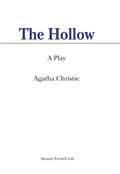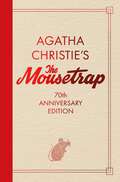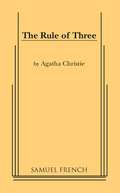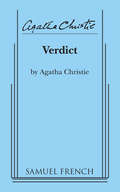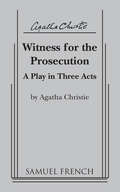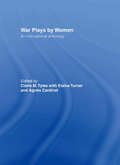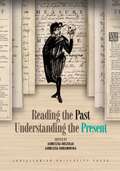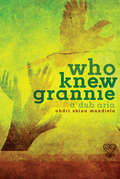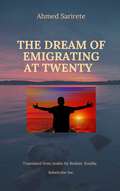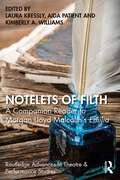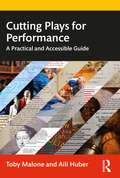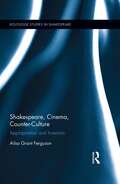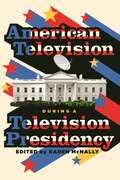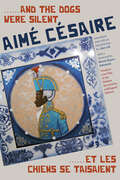- Table View
- List View
The Seven Against Thebes: When A Man's Willing And Eager The God's Join In (Dover Thrift Editions Ser.)
by AeschylusThird play of a trilogy (the other two are lost) about the doomed family of Laius and Oedipus and his sons. After the city of Thebes has banished Oedipus, the former ruler's sons vie for the crown. The victor, Eteocles, expels his brother, Polyneices, who then recruits 7 champions to lead an assault on Thebes, with a tragic results.
The Suppliant Maidens
by AeschylusIn the play, the Danaids, the fifty daughters of Danaus, founder of Argos, flee a forced marriage to their cousins in Egypt. They turn to King Pelasgus of Argos for protection, but Pelasgus refuses until the people of Argos weigh in on the decision, a distinctly democratic move on the part of the king. The people decide that the Danaids deserve protection, and they are allowed within the walls of Argos despite Egyptian protests.
Three Other Theban Plays: Aeschylus' Seven Against Thebes; Euripides' Suppliants; Euripides' Phoenician Women
by Aeschylus EuripidesThough now associated mainly with Sophocles' Theban Plays and Euripides' Bacchae, the theme of Thebes and its royalty was a favorite of ancient Greek poets, one explored in a now lost epic cycle, as well as several other surviving tragedies. With a rich Introduction that sets three of these plays within the larger contexts of Theban legend and of Greek tragedy in performance, Cecelia Eaton Luschnig’s annotated translation of Aeschylus' Seven Against Thebes, Euripides' Suppliants, and Euripides' Phoenician Women offers a brilliant constellation of less familiar Theban plays—those dealing with the war between Oedipus’ sons, its casualties, and survivors.
Fellini: The Sixties (Turner Classic Movies)
by Manoah Bowman Foreword by Anita Ekberg Afterword by Barbara Steele Photographic Editor David Wills Designed by Stephen SchmidtStyle. Beauty. Passion. Vision. These are just a few of the words often used to describe the films of the single most celebrated director in Italy, and one of the most important directors the world has ever known--Federico Fellini. Fifty years since their initial releases, his films of the 1960’s still inspire, shock and delight. More than just encapsulating the 1960’s, these films also helped define the style of the decade. With a staggering twelve Academy Award nominations between his four feature films during this period, Fellini reached the heights of fame, film artistry, and worldwide prominence. Studied, analyzed and re-released over the years, these films continue to amaze each new generation that discovers them. Their impeccable style makes them timeless. Their images make them unforgettable. Their passion brings them to life. And their singular vision makes them unique in all of cinema. Fellini: The Sixties is a stunning photographic journey through the director’s most iconic classics: La Dolce Vita, 8½, Juliet of the Spirits, and Fellini Satyricon. Carefully selected imagery from the Independent Visions photographic archive, many published here for the first time, illuminate these films as they have never been seen before, and reveal fascinating details of the director’s working style and ebullient personality. With more than 150 photographs struck from original negatives, these images spring to life from the page with the depth and quality of the films themselves. Complemented with insightful essays from contemporary writers, Fellini: The Sixties is a true testament to the man and his work, a remarkable compendium to the legendary filmmaker’s greatest achievements.
And Then There Were None
by Agatha ChristieFull Length Play / Mystery Thriller / 8m, 3f / Interior Set. Ten guilty strangers are trapped on an island. One by one they are accused of murder; one by one they start to die. In this superlative mystery comedy statuettes of little soldier boys on the mantel of a house on an island off the coast of Devon fall to the floor and break one by one as those in the house succumb to a diabolical avenger. A nursery rhyme tells how each of the ten "soldiers" met his death until there were none. Eight guests who have never met each other or their apparently absent host and hostess are lured to the island and, along with the two house servants, marooned. A mysterious voice accuses each of having gotten away with murder and then one drops dead - poisoned. One down and nine to go! The excitement never lets up in this ideal play for schools, colleges, and community theatres.
Appointment With Death
by Agatha ChristieFull Length Play / Mystery Thriller / 9m, 7f / Unit Set. An assorted group of travelers are staying at a Jerusalem hotel: Lady Westholme and her companion, a young English doctor and her French colleague, a debonair American and a pugnacious Lancashireman. Another guest, Mrs. Boynton, is a domineering American invalid with four stepchildren whose facade of devotion masks enough hatred to murder her as could the doctor whose affection for Raymond Boynton is being obstructed by the old lady. When Mrs. Boynton is found dead, all are suspects even though she was ill enough to die a natural death. Just when the tension becomes unbearable, the doctor discovers essential evidence about Mrs. Boynton's devilish plan to possess and torment the children in death as in life.
Black Coffee
by Agatha ChristieFull Length Play / Dramatic Comedy, Mystery Thriller / 10m, 3f / Interior Set. This little known mystery will surprise and delight Christie fans. The story concerns a physicist named Sir Claude Amory who has come up with a formula for an atom bomb (Black Coffee was written in 1934!). In the first act, Sir Claude is poisoned (in his coffee, naturally) and Hercule Poirot is called in to solve the case. He does so after many wonderful twists and turns in true Christie tradition.
Go Back for Murder
by Agatha ChristieDrama / 6m,4f / Unit Set. Imprisoned for poisoning her husband fifteen years earlier, Caroline Crale finds herself at death's door, and writes a letter expressing her undeniable innocence to her daughter Carla. Carla, aided by Justin Fogg - a former admirer of Caroline - persuades those present on the day of her father's death to return to the scene of the crime. When the witnesses reassemble, Fogg discovers the identity of the true murderer, and Carla discovers her true feelings for Fogg
Murder on the Nile
by Agatha ChristieDrama, 8m,5f, Interior Set. Simon Mostyn has recently married Kay Ridgeway, a rich woman, having thrown over his former lover Jacqueline. The couple are on their honeymoon on a paddle steamer on the Nile, accompanied by a bevy of memorable characters. Among those present are Canon Pennefather, Kay's guardian, and Jacqueline, who has been dogging their footsteps all through the honeymoon. During the voyage Jacqueline works herself into a state of hysteria and shoots at Simon, wounding him in the knee. A few moments later Kay is found shot in her bunk. By the time the boat reaches its destination, Canon Pennefather has laid bare an audacious conspiracy and has made sure the criminals shall not go free.
Spider's Web
by Agatha ChristieFull Length Play / Mystery Thriller / 8m, 3f / Interior Set. Clarissa, the second wife of Henry Hailsham Brown, is adept at spinning tales of adventure for their bored diplomatic circle. When a murder takes place in her drawing room she finds live drama much harder to cope with, especially as she suspects the murderer might be her young stepdaughter Pippa. Worse still, the victim is the man who broke up Henry's first marriage. Moreover Henry will be arriving shortly with a V.I.P. who might take a dim view of bodies in the drawing room. Clarissa's fast talking places her and Pippa in some hair raising experiences. By the time Henry arrives, the murderer has been unmasked and all is normal so normal that Henry is unable to believe Clarissa when she explains why there are no refreshments for their honored guest.
The Hollow
by Agatha ChristieDrama / 6m,6f / Interior Set. An unhappy game of romantic follow-the-leader explodes into murder one weekend at The Hollow, home of Sir Henry and Lucy Angkatell. Dr. Cristow is at the center of the trouble when his mistress Henrietta, ex-mistress Veronica, and wife Gerda, simultaneously arrive at The Hollow. Also visiting are Edward (who is in love with Henrietta) and Midge (who loves Edward). Veronica ardently desires to marry Cristow and succeeds in reopening their affair but is unable to get him to divorce his wife. Veronica unwisely states that if she cannot have him, no one shall. Within five minutes Cristow is dead. Nearly everyone has a motive and most had the opportunity. Enter Inspector Colquhoun and Sergeant Penny to solve the crime.
The Mousetrap: 70th Anniversary Edition
by Agatha Christie'Even more thrilling than the plot is the atmosphere of shuddering suspense . . . No one brews it better than Agatha Christie' Daily ExpressFor 70 years, Agatha Christie's The Mousetrap has kept millions of people, from every corner of the globe, on the edge of their seats, and it continues to be a sell-out hit of London theatre. This brand new edition of the world's longest-running play will contain a new introduction by Sophie Hannah, bestselling author of the authorised Agatha Christie Poirot continuation novels, as well as the official play script and a host of exclusive material from the show's archives. As news spreads of a murder in London, a group of seven strangers find themselves in a remote countryside guesthouse. When a police sergeant arrives, the guests discover - to their horror - that a killer is in their midst. One by one, the suspicious characters reveal their sordid pasts. Which one is the murderer? Who will be their next victim? And can you solve this world-famous mystery for yourself?This beautiful 70th anniversary edition will contain an introduction by Sophie Hannah, the official playscript, an exclusive interview with producer Adam Spiegel, a treasure trove of letters, speeches, photographs, and other fascinating insights into the making of this iconic play.
The Mousetrap: 70th Anniversary Edition
by Agatha Christie'Even more thrilling than the plot is the atmosphere of shuddering suspense . . . No one brews it better than Agatha Christie' Daily ExpressFor 70 years, Agatha Christie's The Mousetrap has kept millions of people, from every corner of the globe, on the edge of their seats, and it continues to be a sell-out hit of London theatre. This brand new edition of the world's longest-running play will contain a new introduction by Sophie Hannah, bestselling author of the authorised Agatha Christie Poirot continuation novels, as well as the official play script and a host of exclusive material from the show's archives. As news spreads of a murder in London, a group of seven strangers find themselves in a remote countryside guesthouse. When a police sergeant arrives, the guests discover - to their horror - that a killer is in their midst. One by one, the suspicious characters reveal their sordid pasts. Which one is the murderer? Who will be their next victim? And can you solve this world-famous mystery for yourself?This beautiful 70th anniversary edition will contain an introduction by Sophie Hannah, the official playscript, an exclusive interview with producer Adam Spiegel, a treasure trove of letters, speeches, photographs, and other fascinating insights into the making of this iconic play.
The Rule of Three
by Agatha ChristieMelodrama / 5m, 4f / Unit Set. The Rule of Three is a collection of the three short plays: Afternoon At The Seaside, The Rats, and The Patient. Afternoon at the Seaside: The scene is a seashore resort. Among the characters: a siren in a bikini, ogling men and envious women. The undercurrents are perfect for theft. At the very end the wanton siren emerges as a policewoman who solves the otherwise perfect crime. The Rats: nvited to a party in a London flat, Sandra Grey and David Forrester find themselves alone. Somebody knows about their affair and somebody has locked them in. The Patient: Paralysed and unable to speak after she was pushed from her balcony, Mrs Wingfield must find a way to reveal her would-be murderer before they strike again.
Verdict
by Agatha ChristieFull Length Play / Melodrama / 6m, 4f / Interior Set. The Hendryks, refugees in England, have lost everything. Karl with his talents, charm, and hard work rebuilds their lives. But Anya, his wife, is fatally ill and so her old friend, Lisa, who secretly loves karl, lives with them and runs the house. The three are very close. Their serenity is shattered when wealthy, brainless but headstrong Hellen Rolander bribes her way into taking private lessons from Karl. Her infatuation for him being unreturned she doesn't stop at murder to clear the way. But after Anya's dead, Hellen realizing her schemes were futile commits suicide. So Anya's death is pinned on Lisa backed by evidence from a scandal mongering char lady. Lisa's found not guilty and after their mutual agony she and Karl build a new life from the wreckage.
Witness For The Prosecution
by Agatha ChristieFull Length Play / Mystery Thriller / 8m, 5f / Interior Set. Leonard Vole stands in the dock, accused of murder. His wife can prove his innocence but when she takes the stand she denies his alibi. Can he escape the hangman's noose? Winner! New York Critics Circle Award.
War Plays by Women: An International Anthology
by Agnes Cardinal Elaine Turner Claire M. TyleeThis anthology consists of ten plays from countries involved in the First World War, including plays from Germany and France never before available in translation. Representing a range of dramatic forms, from radio play to street-epic, from comic sketch to musical, this anthology includes plays from: Gertrude Stein, Muriel Box, Marion Wentworth Craig, Dorothy Hewett, Berta Lask, Marie Leneru, Wendy Lill, Alice Dunbar Nelson, and Christina Reid. Highly successful in their day, these plays demonstrate how women have attempted to use theatre to achieve social change. The collection explores the historical development of theatrical conventions and genres and the historical context of social and gender issues.
Reading the Past, Understanding the Present
by Agnieszka Orszulak Agnieszka RomanowskaReading the Past, Understanding the Present is a collection of essays written by students from nine European universities, who took part in the Strategic Partnership, “Facing Europe in Crisis: Shakespeare’s World and Present Challenges,” aiming to promote historical understanding of the crises plaguing the contemporary Europe and the world. In each chapter, the authors examine early modern theatre, the works by William Shakespeare in particular, and how it interacts with various local and global issues, reflecting on their cultural and socio-political origins and consequences. This book offers an innovative insight into the relationship between the past represented in such plays as The Merchant of Venice, King Lear, The Tempest</i, or the history plays and the complex contemporary European context – migrant crisis, racial diversity, democracy, or the Covid-19 pandemic.
who knew grannie: a dub aria
by Ahdri Zhina MandielaIn this lyrical masterpiece, four cousins reunite in Jamaica to mourn the passing of their grandmother and to celebrate the times they shared together. There's vilma, an up-and-coming politician; kris, a celebrity chef; tyetye, who's incarcerated; and likklebit, who's immigrated to Canada. As the cousins reminisce about the woman who had such a strong role in rearing them, they uncover their troubles and begin to fulfill grannie's last task: to bring them back in tune with themselves.
The Dream of Emigrating at Twenty (Immigration #1)
by Ahmed SarireteAfter reaching his twentieth birthday, Mourad, a university student, never imagined that the first and riskiest decision that fate would push him to make in his new life would be to immigrate clandestinely, or as the Algerians call it "Harga". Luckily, he knew people who would help him achieve his dream without any financial compensation, but fate was against him every time he tried to accomplish his project, so he finally realized that the secret method of immigration was not designed for him, for a reason only God knows. Therefore, he decided to return home disappointed, after having left without informing his parents of his intention to emigrate. On his way back home, he was once again driven by fate to fulfill his dream of emigrating in another strange way, with a new hope and stimuli he had never imagined!
Notelets of Filth: A Companion Reader to Morgan Lloyd Malcolm's Emilia (Routledge Advances in Theatre & Performance Studies)
by Morgan Lloyd Malcolm Aida Patient Kimberly A. Williams Laura KresslyThis collection of short, accessible essays serves as a supplementary text to Morgan Lloyd Malcolm’s play, Emilia. Critically acclaimed and beloved by audiences, this innovative and ground-breaking show is a speculative history, an imaginative (re)telling of the life of English Renaissance poet Aemilia Bassano Lanyer. This book features essays by theatre practitioners, activists, and scholars and informed by intersectional feminist, critical race, queer, and postcolonial analyses will enable students and their teachers across secondary school and higher education to consider the play’s major themes from a wide variety of theoretical and interdisciplinary perspectives. This volume explores the current events and cultural contexts that informed the writing and performing of Emilia between 2017 and 2019, various aspects of the professional London productions, critical and audience responses, and best practices for teaching the play to university and secondary school students. It includes a foreword by Emilia playwright Morgan Lloyd Malcolm This book will be of great interest to students and scholars of theatre, arts activism, feminist literature, and theory.
Cutting Plays for Performance: A Practical and Accessible Guide
by Toby Malone Aili HuberCutting Plays for Performance offers a practical guide for cutting a wide variety of classical and modern plays. This essential text offers insight into the various reasons for cutting, methods to serve different purposes (time, audience, story), and suggests ways of communicating cuts to a production team. Dealing with every aspect of the editing process, it covers structural issues, such as plot beats, rhetorical concepts, and legal considerations, why and when to cut, how to cut with a particular goal in mind such as time constraints, audience and storytelling, and ways of communicating cuts to a production team. A set of practical worksheets to assist with the planning and execution of cuts, as well as step-by-step examples of the process from beginning to end in particular plays help to round out the full range of skills and techniques that are required when approaching this key theatre-making task. This is the first systematic guide for those who need to cut play texts. Directors, dramaturgs, and teachers at every level from students to seasoned professionals will find this an indispensable tool throughout their careers.
Shakespeare, Cinema, Counter-Culture: Appropriation and Inversion (Routledge Studies in Shakespeare #17)
by Ailsa Grant FergusonAddressing for the first time Shakespeare’s place in counter-cultural cinema, this book examines and theorizes counter-hegemonic, postmodern, and post-punk Shakespeare in late 20th and early 21st century film. Drawing on a diverse range of case studies, Grant Ferguson presents an interdisciplinary approach that offers new theories on the nature and application of Shakespearean appropriations in the light of postmodern modes of representation. The book considers the nature of the Shakespearean inter-text in subcultural political contexts concerning the politicized aesthetics of a Shakespearean ‘body in pieces,’ the carnivalesque, and notions of Shakespeare as counter-hegemonic weapon or source of empowerment. Representative films use Shakespeare (and his accompanying cultural capital) to challenge notions of capitalist globalization, dominant socio-cultural ideologies, and hegemonic modes of expression. In response to a post-modern culture saturated with logos and semiotic abbreviations, many such films play with the emblematic imagery and references of Shakespeare’s texts. These curious appropriations have much to reveal about the elusive nature of intertextuality in late postmodern culture and the battle for cultural ownership of Shakespeare. As there has yet to be a study that isolates and theorizes modes of Shakespearean production that specifically demonstrate resistance to the social, political, ideological, aesthetic, and cinematic norms of the Western world, this book expands the dialogue around such texts and interprets their patterns of appropriation, adaptation, and representation of Shakespeare.
American Television during a Television Presidency (Contemporary Approaches to Film and Media Series)
by Steven Cohan Donna Peberdy Oliver Gruner Hannah Andrews Simon Stow Kathryn Castle Michael Mario Albrecht Aimee Mollaghan Martin Murray Karen McNally Teresa Forde Gregory Frame K. Scott Culpepper Kwakiutl L. Dreher Jessica Ford Rafal Kus Dolores Resano Martin Zeller-JacquesIn American Television during a Television Presidency, Karen McNally and contributors critically examine the various ways in which television became transfixed by the Trump presidency and the broader political, social, and cultural climate. This book is the first to fully address the relationship between TV and a presidency consistently conducted with television in mind. The sixteen chapters cover everything from the political theater of televised impeachment hearings to the potent narratives of fictional drama and the stinging critiques of comedy, as they consider the wide-ranging ways in which television engages with the shifting political culture that emerged during this period. Approaching television both historically and in the contemporary moment, the contributors¾an international group of scholars from a variety of academic disciplines¾illuminate the indelible links that exist between television, American politics, and the nation’s broader culture. As it interrogates a presidency played out through the lens of the TV camera and reviews a medium immersing itself in a compelling and inescapable subject, American Television during a Television Presidency sets out to explore what defines the television of the Trump era as a distinctive time in TV history. From inequalities to resistance, and from fandom to historical memory, this book opens up new territory in which to critically analyze television’s complex relationship with Donald Trump, his presidency, and the political culture of this unsettled and simultaneously groundbreaking era. Undergraduate and graduate students and scholars of film and television studies, comedy studies, and cultural studies will value this strong collection.
......And the Dogs Were Silent/......Et les chiens se taisaient
by Aimé CésaireAvailable to readers for the first time, Aimé Césaire’s three-act drama . . . . . . And the Dogs Were Silent—written during the Vichy regime in Martinique in 1943 and lost until 2008—dramatizes the Haitian Revolution and the rise and fall of Toussaint Louverture as its heroic leader. This bilingual English and French edition stands apart from Césaire’s more widely known 1946 closet drama. Following the slave revolts that sparked the revolution, Louverture arrives as both prophet and poet, general and visionary. With striking dramatic technique, Césaire retells the revolution in poignant encounters between rebels and colonial forces, guided by a prophetic chorus and Louverture’s steady ethical and political vision. In the last act, we reach the hero’s betrayal, his imprisonment, and his last stand against the lures of compromise. Césaire’s masterwork is a strikingly beautiful and brutal indictment of colonial cruelty and an unabashed celebration of Black rebellion and victory.
